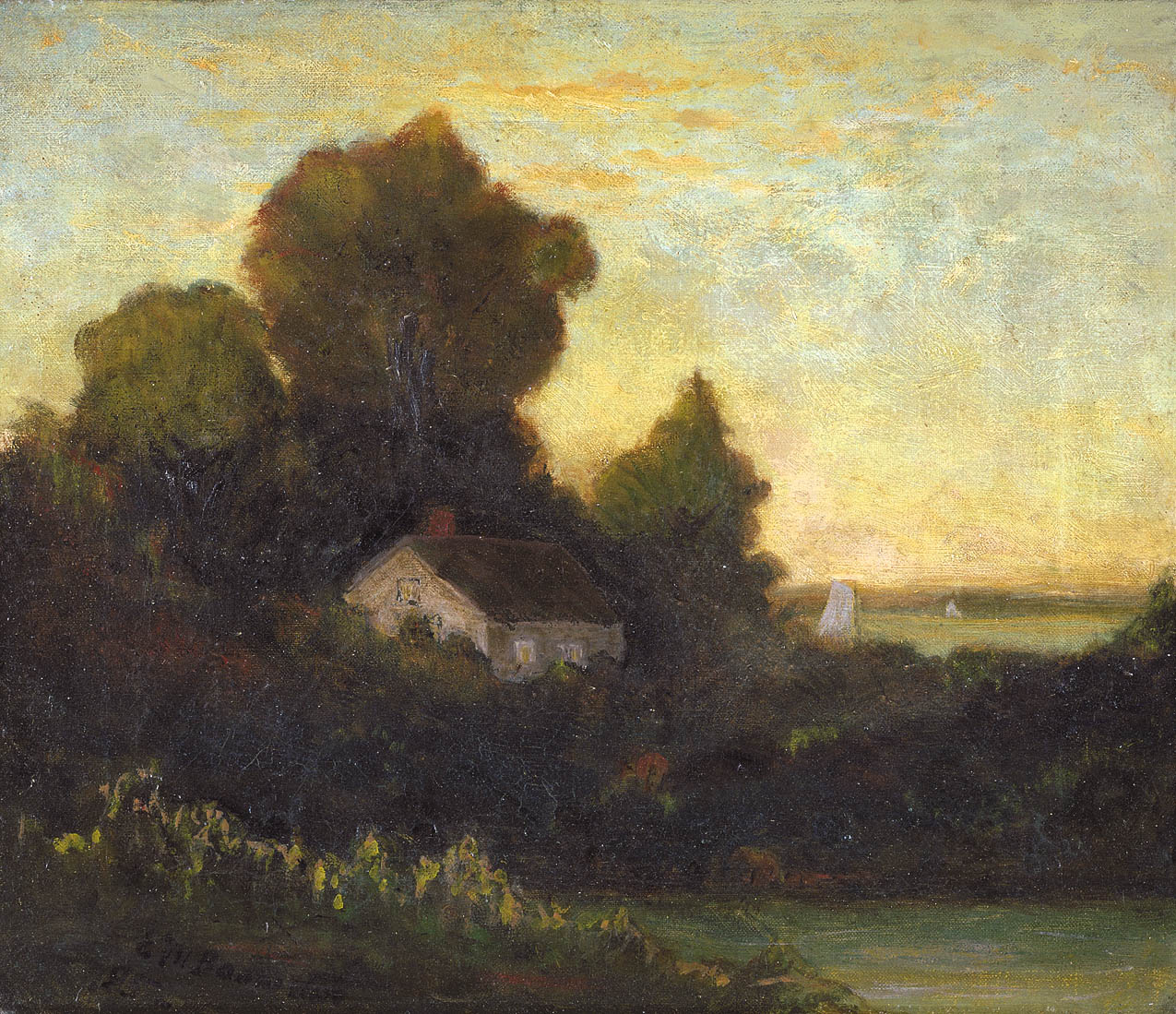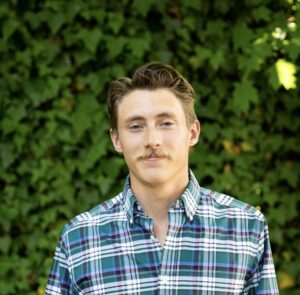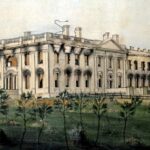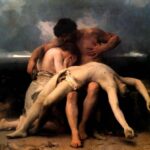Spring descended on the New River Valley in an amalgam of dew and pollen. My grandfather and I drove outside of Blacksburg to visit the cabin that my great-great-great-great-grandfather built. The homestead, which we called the Covey House, had been a topic of conversation over the previous week. Neglecting some now-forgotten academic duty, I rode west with him through the town of Snowville, which boasts a population of 65 people. We followed Lead Mine Road across the pastures and gentle hills that unfurl from the Blue Ridge Mountains.
Pops spoke: “We would ride horses, my grandfather and I, across that hill to this little store, Owens. The proprietor was a lady named Beulah who my mom went to school with.”
I stared at a dilapidated structure in shambles on the street corner. It was surrounded by fields on every side. It was strange to imagine my grandfather traveling on horseback. It seemed antiquarian, and so it was. In his body, he carried a world that I would never know, a conduit that could give emanations of the past but was immanent in the present moment. Today, our trip was in a Honda Pilot, a foreigner to the rocks and trees that watched my grandfather pass them nearly 70 years ago and a mechanical metonym for what the proverbial Lead Mine produced, save the little butts of Swisher Sweets that tussled in the driver-side door. We drove through a small, wooded valley.
“There’s my grandfather’s old house, Millard Covey. I remember helping him harvest tobacco. I’d go up on weekends in autumn, and we’d cut the stalks in the field.”
I watched the memories formulate in his mind, the details emerging like papers shuffled in a forgotten drawer.
“The government would give him an allotment of how much to grow. You know he grew his own seed. We’d go out in the field with the wagon and his two horses. He didn’t own a car. He grew what they call Burley tobacco. When the leaves started turning yellow, we’d cut them with a big s-shaped knife. You’d cut a ridge right in the middle of the stalk.” Being an engineer, Pops never neglects the technical details. “You’d drape the stalks over a tobacco stick and hang them in the barn. I remember one time a lizard ran up my britches in there,” he chuckled. “No doubt my pants came down.”
I smiled and watched the house drift behind us, veiled by the season’s adolescent oak leaves.
“My grandmother would fix us big meals. Always with October beans and honey on the table. He kept bees.”
“Where would he sell the tobacco?”
“Well, his big trip was to Abingdon. After the tobacco cured, he’d make bundles and load them in a borrowed truck. That was his money for the year.”
The age of tobacco has long departed. Looking over a college campus today, you will not see cigarettes and pipes; instead, you will undoubtedly notice small puffs of vape, rising like flutes in the moving mass, the pinnacle of efficiency, concentrated nicotine made easy. The exhalations drift across the “tobacco-free-campus” signs that remind the passersby of the modern, advanced state of academe. My grandfather still enjoys, occasionally, that quiet Baptist pleasure, which Charles Spurgeon called the “blessed leaf.” The history of American tobacco farming, production, and consumption is understandably a long one, entangled in economics, slavery, and lies. But there is something truthful in Millard Covey’s slow, deliberate cultivation. His, his neighbor’s, and his grandsons’ labor transfused into the soft rustling of dried leaves.
We made a final turn and paused at the entrance of a gravel drive. A small cabin set in the bosom of motherly pine trees. As we descended into the clearing, I felt the weight of things unexpressed. It was silent when we got out of the car. The grass was long and wet. The little valley spoke. In his novel To a God Unknown, John Steinbeck wrote of the valley of Nuestra Senora, “The endless green halls and aisles and alcoves seemed to have meanings as obscure and promising as the symbols of an ancient religion.” The richness of symbol was a primary force that drew me to literature, especially to my first love, Steinbeck. When I read Of Mice and Men in high school, I was moved by something inexpressible, meanings that were veiled and irreducible to summary. As T.S. Eliot wrote of Dante, “genuine poetry communicates before it is understood.” And so it was with my first experience of Steinbeck. I quickly read Grapes of Wrath and East of Eden; the same indelible quality persisted.
My early recognition of affect was a type of unknowing development. I could recognize a language that was not linguistic, a symbolic world where I couldn’t pin down the attribute which yielded the effect. I think this mystery draws every earnest scholar to literature, an encounter with something which is profound yet unnamed, a type of aesthetic transfixion.
We do not, however, remain in this moment of symbolic encounter; we naturally and inevitably ask, “Why?” Are there words that can describe what art accomplishes and how it performs its incantations? This, I take it, is the foundational work of the scholar. Despite the recent convulsions and counter-convulsions of literary theory, both the good and the bad, the scholar must ultimately acknowledge one’s identity as a reader, as a kid who cries over something more than sentiment. Without carrying this identity, our encounters with literature become at best embalmed and at worst ideological. The pursuit of the critical cannot be untethered from the encounter. Steinbeck was my pathway into both. I wrote my first scholarly work, an undergraduate thesis, on East of Eden. It was wonderfully naïve and overreaching and written with the most undaunted prose imaginable. And although there was dross to burn, the core of that project still communicated the enamor of first encounters.
Pops and I walked across the outstretched clearing. The house was hemmed in by a wooden fence, the beams of which were lazily crossed in horizontal “Xs.” The cabin’s architect and builder was Elijah Covey, the grandson of Samuel Covey, a Scottish immigrant who arrived in the New World in 1760. Samuel settled in Virginia, buying 2,000 acres of the Patton Grant at 10 cents an acre. This historical record, endowed to me by my uncle’s work, was preserved by Millard Covey, our family’s own poet laurate. He wrote a narrative poem titled “The Generations,” a family history that covers everything from genealogy, daily life on the farm, and even a Confederate occupation. Millard frames the opening section of his poem as a letter to his grandfather, “Dear Grandfather Samuel–Here I stand, / Which they say, was once your land.” The poem mostly consists of such couplets but is interspersed with statements of fact, delivered without regard for meter or rhyme. Its tone is that of a family historian, informal and sincere.
We soaked in the morning and our coffee, aware that we were technically trespassing. But, at the moment, we felt the weight of heritage, a complicated term that outmatched the real-estate deeds housed in Pulaski county courthouse. We peered through any windows we could manage; the house was mostly empty, save some scattered furniture and boxes. The chimney was made from grey and tan stone. It was half the size of the house, no doubt the great pride of her builders, the jewel set in the timber frame. The bottom of the chimney cascaded into a larger stone patio of the same rock. Despite the improvements to the cabin, the chimney looked untouched, bearing on its surface smooth channels, the watermarks of a century of Appalachian rain.
Among his many interesting hobbies, Millard Covey was said to have been a “sculptor of river stones.” When Pops and I visited the cabin, I was working on my master’s thesis which focused on another sculptor of stone, the Californian poet Robinson Jeffers. For Jeffers, rock was fecund with meaning; he expressed such thoughts in “To the Stone-Cutters.” He opens the poem: “Stone-cutters fighting time with marble, you foredefeated / challengers of oblivion.” In typical Jeffers fashion, the poem is marked with his distinct sense of human tragedy. He writes that humanity will “be blotted out, the blithe earth die, the brave sun / Die blind and blacken to the heart.” He compares the poet’s work to the stone mason’s; both of their products are doomed to pass away. He ends the poem, however, in a modest affirmation of life and work: “Yet stones have stood for a thousand years, and pained / thoughts found / The honey of peace in old poems.” Jeffers makes the direct connection between art and the natural world. He continually challenged the Cartesian turn, which placed the human consciousness, an imagined objective and ambivalent observer, outside the material environment. For Jeffers, art and beauty and poetry were inextricable from place. Stones were a type of poetry and poetry a type of stone. This was reflected in his own words about the proper subject for the poet: “Permanent things, or things forever renewed, like the grass and human passions, are the material for poetry.” These permeant things were more than their mere material, scientific presence; beauty was as real as the atom, and they were, for Jeffers, one and the same in substance.
Jeffers helped me recognize aesthetic transfixion in the natural world. This transposition was enabled by other environmental writers: Edward Abbey, Wendell Berry, Annie Dillard, Tom Gardner, Rachel Carson, Robin Wall Kimmerer, and Aldo Leopold. They directed my eyes in a way that fiercely countered positivist reduction. Life was saturated with beauty and meaning. Although giving different accounts of such meaning, they shared a belief that the natural world warranted contemplation as something more than a mere array of resources. The environment was active in shaping the self. Collectively, their work is stanchly anti-Cartesian and represents a bedrock of conservational thought. They taught me the ancient lesson that the aesthetic and the material are not antagonists but lovers.
We circled the house together, closely inspecting its construction. The cabin has two stories: the bottom story is made of horizontal beams and plaster; the second story is framed differently, using perpendicular planks to panel the walls. I could not help but think, which I presume to be a common human impulse, of the history that this house had endured. That little upstairs space saw the widowed Katty Covey with her two-year-old son Charles, Millard’s father, held captive by Confederate sympathizers. Millard chronicles the event:
They ate all the food that grandmother had
Left nothing for her and two year old Dad.
They stayed for weeks to catch her two sons
Scouting from serving South they had shun.
…
They took charge of her living room and forced her
up stairs.
They heat the floor so hot on her feet so bare.
When the war was over and the North had won
Then is when the Home Guards run.
Who was this woman who endured theft, occupation, and captivity? She must have been terrified, trying to protect her fleeing step-sons and toddler. What fortitude enabled her to calm the hunger pains of little Charles when she was all too mindful of the gnawing in her own stomach? She must have watched, from that second story window, the winter’s snow gild the valley and heard below the rough laughter of men. When the war was over, Katty lived out her days with Charles. Millard records her death from the perspective of his childhood: “I stood at the foot of her bed / But too young to realize she was dead. / Her coffin was made of walnut of the best / In the ‘Covey-Hall Cemetery’ there to rest.” I know her story, but I do not know Katty. When the upstairs floor gets hot, I’m sure the walls still whisper about her.
We moved behind the house where the bank cuts steeply down toward a small creek. The creek was thin and cold and quiet. I traced its curl down the gully and out to the pasture, resting two hundred yards downhill. Pops motioned beyond.
“We would ride our horses over that hill.”
I gestured, “You could have a fine garden down in the flat.” There was a worn, faint path that descended to the creek. The wisps of grass speckled the ground like weekend stubble.
We stood together in silence, listening to the finches and cardinals engage in soft conversation. As my eyes swept the valley, my mind reeled from the deep draughts of vision-permeated air. I remember thinking that I would trade classrooms, publications, and the little array of letters that would sit before my name to live here. I could see my wife and I raising a family in the little cabin. Our rambunctious children would stumble and run across the clearing; there would be laughter and heartache and skinned knees and quiet evenings. I was twenty-two at the time, the same age that Millard eloped with his wife Nannie; they were married for sixty-nine years. Such a future yawned across the land. I could trace slow lines of cultivation in little orchards and small trellises of sour grapes. Big tomatoes, German Pinks, would hang like softballs, bending their stalks like the spine of a fly rod. I saw the blooms of unplanted dogwoods.
“Do you know who owns it?”
“I reckon they would know.” Pops pointed to a modern brick home that was across the way. “Let’s do some investigating.”
The beauty of the Covey House intertwined permanent things and temporality; the past and the present; the living and the dead. We might call this beauty an inheritance, not a financial one but an invitation. It was an invitation to dwell, a call into an unseen community. Millard Covey wrote of such a community. In his section titled, “The Second Generation,” he writes:
All neighbors would join in to raise the barns,
To house the tobacco grown on the farms.
At night all join in to have some fun
Dancing, promenading with just a little rum.
Stills were legal at that day,
No taxes, no sheriff to pay.
Their wives would yell, “oh my toes and shins,
You men have had too much gin.”
Each Scottish figure they tried out well,
Then laugh and say, “aren’t we swell.”
Sometimes the sun was shining bright,
Not realizing they had danced all night.
A late breakfast for that day
But the blessing they would always say.
Good neighbors they all were, in all forms of help
No money to pay out, just their own self.
My great-great grandfather’s couplets are wonderfully simple. He recognized that there was a life and a land to conserve. The community which Millard envisioned was specifically a Christian one. He writes of his father, Charles: “My father a great Bible reader and scholar / For wisdom and understanding I do will to follow” (The correct Appalachian pronunciation of the last word is most certainly “foller”). And indeed he did; Millard was a rural theologian. Pops recounts how he scribbled Biblical genealogies at his grandfather’s dictation, compiling the story of the universe form the hills of Pulaski. His depiction of community in “The Generations” is deeply entwined with faith, a faith that brought Samuel across the Atlantic, that bulwarked Katty, and that united a community of neighbors.
I deeply resonate with Millard’s vision. I see an aesthetic, rather than acetic, theology. It is an orthodoxy that, as G.K. Chesterton would describe, is like “a thick steak, a glass of red wine, and a good cigar.” Such a robust belief is not daunted by Nietzschean accusations of cold sterility. When Nietzsche spoke of Dionysus and dance, he didn’t see the God who turned water into wine and praised the “leaping and dancing” of David (2 Samuel 6:16). Nor could such a paradigm see the Covey’s barn raising, replete with its mountain gin and twirling jigs. The Covey house that I encountered was aflash with such theology, a vision of what the dwelling could become, a quiet murmuring of Christian community that T.S. Eliot described as “a society in which the natural end of man—virtue and well-being in community— is acknowledged for all, and the supernatural end—beatitude— for those who have the eyes to see it.”
We reached the nearby house and knocked. No one was home. I later found the property deed and wrote a letter to the brick house, but that was all. I never heard back. My wife and I visited a few weeks later. I haven’t been back since.
Each spring I read Norman Maclean’s A River Runs Through It. It has become a sort of ritual. I invited Pops, a lifelong fisherman, to join me last year. The final line of the novel is famous: “I am haunted by waters.” I am haunted too but not by waters. There sits, this very morning, a little cabin in a clearing of pines. Light rushes through the evergreens and strikes the long tendrils of grass. I search for that light often, for the beams that abruptly appear in our lives. I have a theory, though unsubstantiated, that such refractions tend to loaf in the rafters of old tobacco barns, laughing together among the leathery fronds.
In the same closing paragraph, Maclean writes of “words” that are hidden under rocks from the “basement of time.” There are words in the Covey valley, hiding in the stone chimney, and “some of the words are theirs.” If you visit and sit quietly and listen, you might hear the unspeakable murmur. The poet’s impossible undertaking is to translate these murmurings into language. It was Millard’s task, and it also is mine. At the end of “The Generations,” there is a poetic transformation. When Millard picks up the theme of his own life, his factual verse is eclipsed by the personal and poetic. He tries to give us words. He offers us a benediction:
But now our days have passed and twilight is here
We should live righteously with nothing to fear
To you dear children your twilight is ever to come
But try and live for the rising of a new sun.
Image credit: “Untitled (house in woods near lake)” by Edward Mitchell Bannister via Wikimedia






